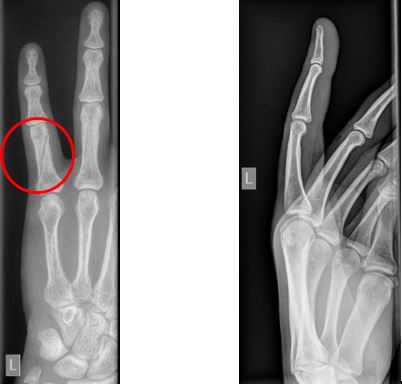When you injure yourself, most of the time the first thought that pops into your head is “Oh no, I hope I haven’t broken it!” It’s common to think that breaking a bone is the most severe injury you can sustain and one that will put you out of action for the longest period of time. But is breaking a bone really the worst thing that could happen? Not always.
For example, here are two different xrays of two separate finger injuries. The left xray shows a fracture of the proximal phalanx of the little finger. The xray on the right shows a finger with no fractures. From looking at these xrays alone, most people would prefer to be the person on the right who doesn’t have any broken bones.

However, what the xray doesn’t show is that in this instance the person on the right has actually sustained a ruptured flexor tendon to the finger, which requires surgical repair and a post operative rehabilitation timeframe of a minimum of 12 weeks. This is in comparison to the person on the left who would be placed into a thermoplastic splint and is looking at a recovery timeframe of 4-8 weeks.
What many people don’t realise is that the ‘soft tissue’ structures in our body can be large, important structures that play a vital role in the stability of our joints and overall function. This is particularly true with regards to hand or wrist function. There are three main soft tissue structures that can injured in the upper limb and these structures will recover with varying timeframes after injury. These three structures are:
- Ligaments – Ligaments are fibrous structures that stabilise our joints. Ligaments can sometimes be thought of like a hinge – they allow our joints to move in certain directions but stop them from moving in directions they shouldn’t, for example hyperextension of your finger joints. Ligaments are frequently injured in sporting accidents, where our joints get over-stretched by a sudden force. Ligaments can be sprained, partially torn or fully torn. Ligaments have a more complex internal structure but less blood supply than bone, and can take approximately 6-8 weeks to heal following injury. If you have fully ruptured a ligament, this usually requires surgical repair.
- Tendons– Tendons are dense fibrous structures that are responsible for movement of our joints. Our tendons are the rope-like structures that connect our bones to our muscles to facilitate movement. Our hands in particular have many long tendons that are susceptible to injury through lacerations or sudden resistive forces. Some tendon injuries can be managed with splinting (depending on the type of tendon and location of injury), however many tendon injuries typically require surgical repair. Our tendons have a complex internal structure and require good strength in order to move our joints, and typically take up to 12 weeks to heal following injury or surgery.
- Nerves– Our nerves are the information messengers of our body. They are made up of connective tissue and are even more complex in nature than bones, ligaments and tendons. A nerve is made up of multiple organised structures that allow transmission of sensory and motor information. Our nerves are responsible for sensory information such as temperature recognition and tactile discrimination, and are also the power supply for our muscles. Nerves can be injured in multiple ways – they can be compressed by force (such as a tourniquet) or excess swelling in a region, can be stretched (by falling or sleeping in an awkward position for too long), or lacerated. Nerve injuries are classified by the severity of the damage to the nerve, ranging from mild (eg. bruising of the nerve) to severe (eg. full laceration of a nerve). All classifications of nerve injuries can result in sensory deficits and associated motor paralysis. Nerves are incredibly complex in nature given their important function. In the instance of bruising of a nerve (called a neuropraxia) surgical repair is not required and the nerve can take anywhere between a couple of days or up to 12 weeks to recover. In the instance that a nerve is lacerated, surgical repair is required. If the internal structures of a nerve are injured, either through laceration or severe compression, the nerve will need to regenerate itself from the point of injury down to the tips of the fingers. The rate at which this occurs is only 1-2mm a day – this means that depending on the location of the injury, nerve injuries may take anywhere between 3-18 months to recover.
In comparison to our soft issue structures, bones have a reasonably simple structure and generally have a good blood supply, which allows them to heal quicker than our ligaments or tendons. In many situations sustaining a fractured bone can be the lesser of two evils and potentially be a simpler injury to have. If you’ve had an injury to your hand or wrist and had an x-ray that’s come back clear, always remember that there may be some “soft tissue damage” that has the potential to be problematic! If you think this has happened to you, contact a hand therapist to have your injury assessed and managed appropriately.
If you suspect you’ve injured yourself or are concerned about a lingering problem with your hand or wrist, call 5221 7171 or make a booking online to see one of our therapists.
